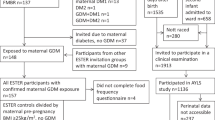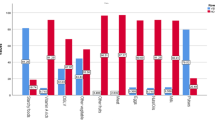Abstract
Background/Objectives:
To describe the diet quality of a national sample of Australian women with a recent history of gestational diabetes mellitus (GDM) and determine factors associated with adherence to national dietary recommendations.
Subjects/Methods:
A postpartum lifestyle survey with 1499 Australian women diagnosed with GDM ⩽3 years previously. Diet quality was measured using the Australian recommended food score (ARFS) and weighted by demographic and diabetes management characteristics. Multinominal logistic regression analysis was used to determine the association between diet quality and demographic characteristics, health seeking behaviours and diabetes-related risk factors.
Results:
Mean (±s.d.) ARFS was 30.9±8.1 from a possible maximum score of 74. Subscale component scores demonstrated that the nuts/legumes, grains and fruits were the most poorly scored. Factors associated with being in the highest compared with the lowest ARFS quintile included age (odds ratio (OR) 5-year increase=1.40; 95% (confidence interval) CI:1.16–1.68), tertiary education (OR=2.19; 95% CI:1.52–3.17), speaking only English (OR=1.92; 95% CI:1.19–3.08), being sufficiently physically active (OR=2.11; 95% CI:1.46–3.05), returning for postpartum blood glucose testing (OR=1.75; 95% CI:1.23–2.50) and receiving risk reduction advice from a health professional (OR=1.80; 95% CI:1.24–2.60).
Conclusions:
Despite an increased risk of type 2 diabetes, women in this study had an overall poor diet quality as measured by the ARFS. Women with GDM should be targeted for interventions aimed at achieving a postpartum diet consistent with the guidelines for chronic disease prevention. Encouraging women to return for follow-up and providing risk reduction advice may be positive initial steps to improve diet quality, but additional strategies need to be identified.
This is a preview of subscription content, access via your institution
Access options
Subscribe to this journal
Receive 12 print issues and online access
$259.00 per year
only $21.58 per issue
Buy this article
- Purchase on Springer Link
- Instant access to full article PDF
Prices may be subject to local taxes which are calculated during checkout
Similar content being viewed by others
References
Hoffman L, Nolan C, Wilson JD, Oats JN, Simmons D . Gestational diabetes mellitus—management guidelines. Med J Aust 1998; 169: 93–97.
Templeton M, Pieris-Caldwell I Gestational Diabetes Mellitus in Australia, 2005–06. Australian Institute of Health and Welfare: Canberra, 2008.
Kitzmiller J, Dang-Kilduff L, Taslimi MM . Gestational diabetes after delivery: short-term management and long-term risks. Diabetes Care 2007; 30: S225–S235.
Lee A, Hiscock RJ, Wein P, Walker S, Permezel M . Gestational diabetes mellitus: clinical predictors and long-term risk of developing type 2 diabetes. Diabetes Care 2007; 30: 878–883.
The Diabetes Prevention Program Research Group. Reduction in the incidence of type 2 diabetes with lifestyle intervention or metformin. N Engl J Med 2002; 346: 393–403.
Koh D, Miller YD, Marshall AL, Brown WJ, McIntyre D . Health-enhancing physical activity behavior and related factors in postpartum women with recent gestational diabetes mellitus. J Sci Med Sport 2010; 13: 42–45.
Smith BJ, Cheung NW, Bauman AE, Zehle K, McLean M . Postpartum physical activity and related psychosocial factors among women with recent gestational diabetes mellitus. Diabetes Care 2005; 28: 2650–2654.
Zehle K, Smith B.J, Chey T, McLean M, Bauman A.E, Cheung N.W . Psychosocial factors related to diet among women with recent gestational diabetes: opportunities for intervention. Diabetes Educator 2008; 34: 807–814.
Kieffer EC, Sinco B, Kim C . Health behaviors among women of reproductive age with and without a history of gestational diabetes mellitus. Diabetes Care 2006; 29: 1788–1793.
Stage E, Ronneby H, Damm P . Lifestyle change after gestational diabetes. Diabetes Res Clin Pract 2004; 63: 67–72.
Fung TT, McCullough M, van Dam RM, Hu FB . A prospective study of overall diet quality and risk of type 2 diabetes in women. Diabetes Care 2007; 30: 1753–1757.
Hodge AM, English DR, O'Dea K, Giles GG . Dietary patterns and diabetes incidence in the Melbourne Collaborative Cohort Study. Am J Epidemiol 2007; 165: 603–610.
Montonen J, Järvinen R, Heliövaara M, Reunanen A, Aromaa A, Knekt P . Food consumption and the incidence of type II diabetes mellitus. Eur J Clin Nutr 2005; 59: 441–448.
Nettleton JA, Steffen LM, Ni H, Liu K, Jacobs DR . Dietary patterns and risk of incident type 2 diabetes in the multi-ethnic study of atherosclerosis (MESA). Diabetes Care 2008; 31: 1777–1782.
Esposito K, Kastorini CM, Panagiotakos DB, Giugliano D . Prevention of type 2 diabetes by dietary patterns: a systematic review of prospective studies and meta-analysis. Metab Syndr Relat Disord 2010; 8: 471–476.
Fung TT, Schulze M, Manson JE, Willett WC, Hu FB . Dietary patterns, meat intake, and the risk of type 2 diabetes in women. Arch Intern Med 2004; 164: 2235–2240.
Wirt A, Collins CE . Diet Quality - what is it and does it matter? Public Health Nutr 2009; 12: 2473–2492.
Collins CE, Young AF, Hodge A . Diet quality is associated with higher nutrient intake and self-rated health in mid-aged women. J Am Coll Nutr 2008; 27: 146–157.
Hu FB, Manson JE, Stampfer MJ, Colditz GA, Liu S, Solomon CG, Willett WC . Diet and lifestyle and risk of type 2 diabetes mellitus in women. New Engl J Med 2001; 345: 790–797.
Morrison MK, Lowe JM, Collins CE . Perceived risk of type 2 diabetes in Australian women with a recent history of gestational diabetes mellitus. Diabet Med 2010; 27: 882–886.
Trewin D Census Dictionary. Australian Bureau of Statistics, Commonwealth of Australia. Australian Bureau of Statistics: Canberra, 2001.
Armstrong T, Bauman A, Davies J Physical Activity Patterns of Australian Adults. Results of the 1999 National Physical Activity Survey. Australian Institute of Health and Welfare: Canberra, 2000.
Brown WJ, Trost SG, Bauman A, Mummery K, Owen N . Test-retest reliability of four physical activity measures used in population surveys. J Sci Med Sport 2004; 7: 205–215.
Australian Institute of Health and Welfare. The Active Australia Survey: a Guide and Manual for Implementation, Analysis and Reporting. Australian Institute of Health and Welfare: Canberra, 2003.
Kant AK, Thompson FE . Measures of overall diet quality from a food frequency Questionnaire: National health interview survey 1992. Nutr Res 1997; 17: 1443–1456.
Ireland P, Jolley D, Giles G, O’Dea K, Powles J, Rutishauser I, Wahlqvist ML, Williams J . Development of the Melbourne FFQ: a food frequency questionnaire for use in an Australian prospective study involving an ethnically diverse cohort. Asia Pac Clin Nutr 1994; 3: 19–31.
Hodge A, Patterson A, Brown W, Ireland P, Giles G . The anti cancer council of Victoria FFQ. Relative validity of nutrient intakes compared with diet diaries in young to middle-aged women in a study of iron supplementation. Aust NZ J Public Health 2000; 24: 576–583.
Commonwealth of Australia, National Health and Medical Research Council. Dietary Guidelines for Australian Adults: A Guide to Healthy Eating. Australian Government Publishing Service: Canberra, Australia, 2003.
Smith A, Kellett E, Schmerlaib Y The Australian Guide to Healthy Eating. Australian Government Publishing Service: Canberra, 1998.
Hure A, Young A, Smith R, Collins C . Diet and pregnancy status in Australian women. Public Health Nutr 2009; 12: 853–861.
Blumfield ML, Hure AJ, Macdonald-Wicks LK, Patterson AJ, Smith R, Collins CE . Disparities exist between National food group recommendations and the dietary intakes of women. BMC Women’s Health 2011; 8: 11–37.
de Munter JS, Hu FB, Spiegelman D, Franz M, van Dam RM . Whole grain, bran, and germ intake and risk of type 2 diabetes: a prospective cohort study and systematic review. PLoS Med 2007; 4: e261.
Venn BJ, Mann JI . Cereal grains, legumes and diabetes. Eur J Clin Nutr 2004; 58: 1443–1461.
Belin RJ, Greenland P, Allison M, Martin L, Shikany JM, Larson J, Tinker L, Howard BV, Lloyd-Jones D, Van Horn L . Diet quality and the risk of cardiovascular disease: the Women's Health Initiative (WHI). Am J Clin Nutr 2011; 94: 49–57.
Darmon N, Drewnowski A . Does social class predict diet quality? Am J Clin Nutr 2008; 87: 1107–1117.
Holdenson Z, Catanzariti L, Phillips G, Waters AM . A picture of diabetes in overseas-born Australians. Australian Institute of Health and Welfare 2003.
Blatt AJ, Nakamoto JM, Kaufman HW . Gaps in diabetes screening during pregnancy and postpartum. Obstet Gynecol 2011; 117: 61–68.
Shah BR, Lipscombe LL, Feig DS, Lowe JM . Missed opportunities for type 2 diabetes testing following gestational diabetes: a population-based cohort study. BJOG 2011; 118: 1484–1490.
Morrison MK, Collins CE, Lowe JM . Postnatal testing for diabetes in Australian women following gestational diabetes mellitus. Aust NZ J Obstet Gynaecol 2009; 49: 494–498.
Morrison MK, Collins CE, Lowe JM . Dietetic practice in the management of gestational diabetes mellitus: A survey of Australian dietitians. Nutr Dietetics 2011; 68: 189–194.
Knowler WC, Barrett-Connor E, Fowler SE, Hamman RF, Lachin JM, Walker EA, Nathan DM . Reduction in the incidence of type 2 diabetes with lifestyle intervention or metformin. N Engl J Med 2002; 346: 393–403.
Louheranta J, Mannelin A, Rastas M, Salminen M, Eriksson V, Uusitupa M, Tuomilehto J . The Finnish Diabetes Prevention Study (DPS): lifestyle intervention and 3-year results on diet and physical activity. Diabetes Care 2003; 26: 3230–3236.
Pan XR, Li GW, Hu YH, Wang JX, Yang WY, An ZX et al. Effects of diet and exercise in preventing NIDDM in people with impaired glucosetolerance. The Da Qing IGT and Diabetes Study. Diabetes Care 1997; 20: 537–544.
Shah BS, Freeland-Graves JH, Cahill JM, Lu H, Graves GR . Diet quality as measured by the healthy eating index and the association with lipid profile in low-income women in early postpartum. JADA 2010; 110: 274–279.
Laraia BA, Bodnar LM, Siega-Riz AM . Pregravid body mass index is negatively associated with diet quality during pregnancy. Public Health Nutr 2007; 10: 920–926.
Burton NW, Brown W, Dobson A . Accuracy of body mass index estimated from self-reported height and weight in mid-aged Australian women. Aust NZ J Public Health 2010; 34: 620–623.
Acknowledgements
We are very grateful to the women with GDM whose participation made this study possible. This study was funded by the Diabetes Australia Research Trust, the University of Queensland’s Enabling Grants Scheme, the National University of Malaysia PhD Scholarship, the Dietitians Association of Australia Unilever Post-Graduate Research Scholarship, the Lions District 201N3 Diabetes Foundation and the Neville Samson Diabetes Grants-In-Aid. CE Collins if funded by a National Health and Medical Research Council Career Development Fellowship. We acknowledge David McIntyre and Wendy Brown for input into the sampling strategies and reviewing the measures used, and the National Diabetes Services Scheme and Diabetes Australia-NSW for their support.
Author information
Authors and Affiliations
Corresponding author
Ethics declarations
Competing interests
The authors declare no conflict of interest.
Rights and permissions
About this article
Cite this article
Morrison, M., Koh, D., Lowe, J. et al. Postpartum diet quality in Australian women following a gestational diabetes pregnancy. Eur J Clin Nutr 66, 1160–1165 (2012). https://doi.org/10.1038/ejcn.2012.84
Received:
Revised:
Accepted:
Published:
Issue Date:
DOI: https://doi.org/10.1038/ejcn.2012.84



